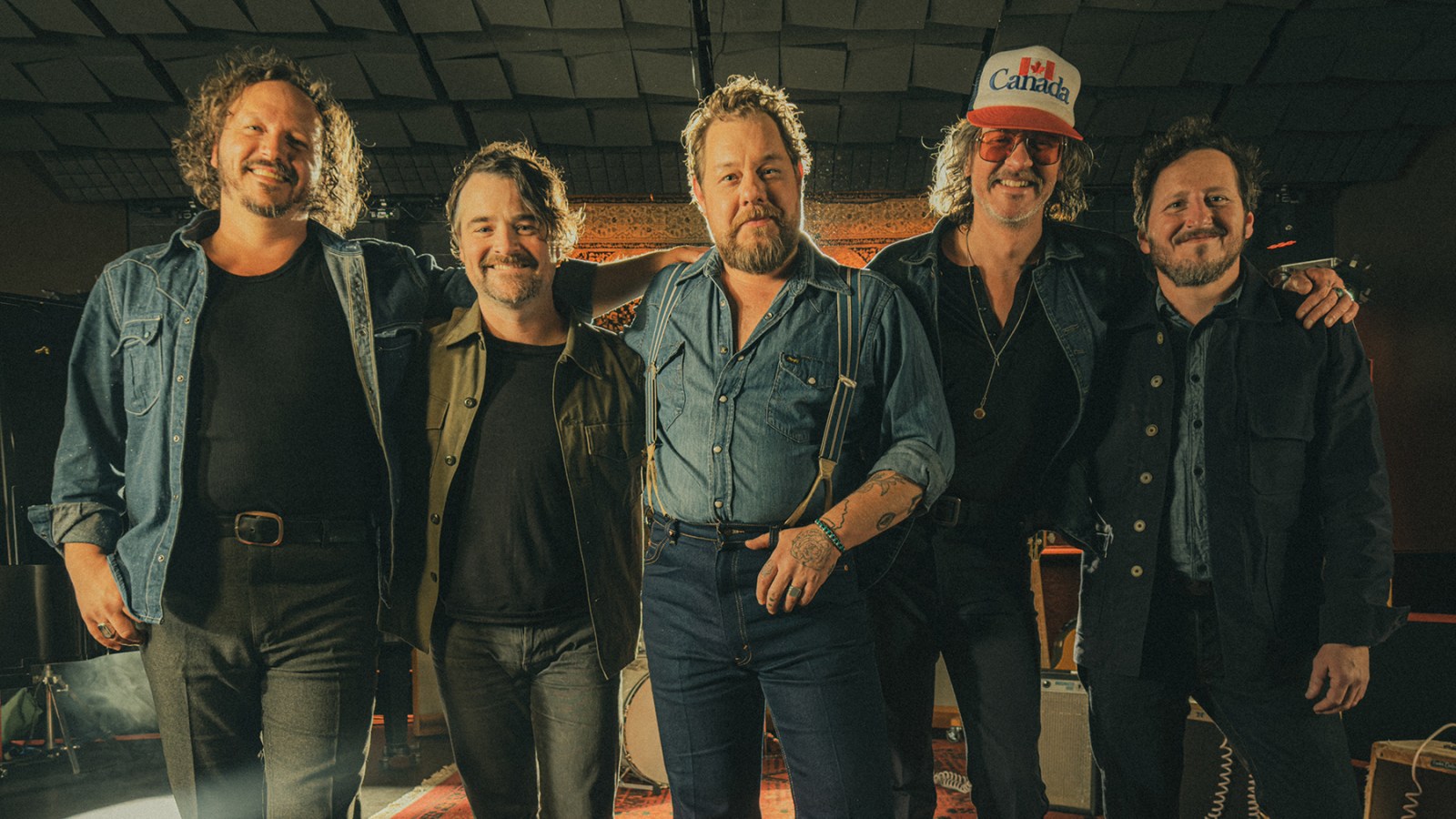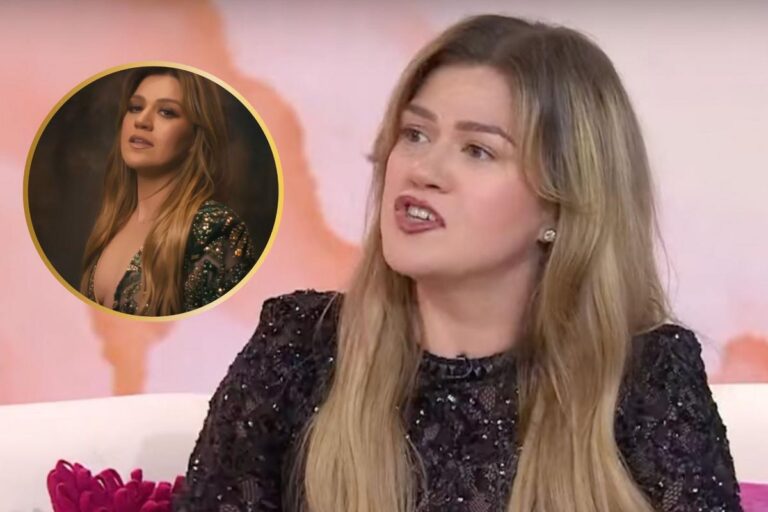Last year, Nathaniel Rateliff and the Night Sweats began making the leap from theaters to arenas, culminating in a headlining show at New York’s Madison Square Garden two months ago. But as Rateliff tells it, fans almost didn’t see him there or anywhere else on the tour, which had been set up to promote the band’s fourth album, South of Here.
“At the beginning of the record cycle, I was having so much struggle with anxiety that I almost pulled all the dates down for the year,” Rateliff says matter-of-factly, chilling on a balcony of a New York hotel room. “We had, like, six weeks in Europe leading up to the album release. And I was having such a hard time that I thought I wasn’t going to tour at all.”
Looking more or less how one would expect him to look — floppy flannel shirt over a white T-shirt, baggy jeans, and cap — Rateliff recounts what came next: “a lot of personal work over the last year and a half” and recruiting “a great therapist” to help him overcome the pressure he was feeling. With a self-deprecating smile, he adds, “Part of that was just not drinking at all, which helps.”
https://www.youtube.com/watch?v=-UBxAS4KbOE
Rateliff did manage to overcome his anxiety and complete the entire tour, and even enjoy it at times. “It’s really easy to forget that it’s supposed to be a joyous celebration to be onstage,” he says. “And even if some of the songs are emotive or about hard topics, it’s still a beautiful experience to share with people.” To further delve into how he arrived at such a space — and worked his way out of it — Rateliff has turned to music videos. In the clip for the title track of South of Here, he both visualizes and pokes fun at the angst that’s periodically threatened to derail his career.
By 2015, Rateliff had already been kicking around the Colorado music scene for years, playing in several un-Night Sweatsy bands (like the alt-rocking Born in the Flood) and making an unplugged solo record but still feeling directionless. As Rateliff points out, it was 10 years ago this summer that he and his next band, the R&B-influenced Night Sweats, went viral after performing “S.O.B.” on The Tonight Show Starring Jimmy Fallon. “If you believe in soul … if you believe in rock n roll …,” Fallon tweeted at the time, “enjoy the band on our show tonight.”
Thanks to Fallon’s boost and Rateliff’s musical and physical makeover (imagine a member of the Band sitting in on a soul revue), Rateliff suddenly achieved liftoff. “Twenty years of me trying to have a music career and then we play Fallon and blow up,” he says. Along with like-minded souls like the Tedeschi Trucks Band and Lake Street Dive, Rateliff and the Night Sweats became part of a loose-knit movement of Americana-style bands who built devoted followings over time, with little radio play, and graduated to larger halls and arenas.
Along the way came perks, like playing “Graceland” onstage with Paul Simon, being invited to join Stephen Stills and Neil Young at last month’s Light Up the Blues benefit in Los Angeles or, years ago, seeing The Irishman in a Nashville movie theater with one of his heroes, John Prine. “Fiona, his wife, was like, ‘You sit next to John,’ so I was sitting next to him sharing his popcorn,” he says with a fond smile. “A surreal moment. I felt very close to John.”
Nathaniel Rateliff battled anxiety that nearly knocked him off the road. But therapy and quitting drinking helped him find peace.
Brantley Gutierrez*
But plenty of downsides came with Rateliff’s breakthrough. For someone prone to a degree of carousing (“S.O.B.” emerged during a troubled patch in his first marriage, complete with much drinking on his part), the road wasn’t the best place to avoid partying. He was drinking so much during the making of the band’s second album that he had to stop toward the end to finish it. In 2018, one of his musical compadres — musician, producer, and studio owner Richard Swift — died of complications from hepatitis as a result of his own excesses, just as the two were about to start a Rateliff solo album. Rateliff says he still thinks about Swift “every day.”
The commercial letdown of his and the Night Sweats’ 2021 album The Future even made Rateliff doubt his own future. “You’re just scared that the bottom is always going to fall out from anything you’re doing and you’re trying to do what people are going to connect with without chasing trends,” he says. “And for that record in particular, I was like, ‘Well, what in the fuck are we right now?’” The record’s muted response was also another reminder to Rateliff that he was essentially running a business. “You start off as a songwriter and a relatively fragile person, and then the next thing you know, you’re also running a corporation and making decisions that affect people’s lives who are in your life,” he says. “I wouldn’t say it’s beneficial to somebody who’s stressed.”
The band’s fourth album, last year’s South of Here, was a more relaxed effort, and the new video for its title track, shot over a few days in Colorado, finds Rateliff both acting out the issues that almost led to his canceled tour and attempting to find some humor in them. The storyline — a despondent Rateliff wandering around in barren, sometimes snowy landscapes — was actually inspired, he says, by the 1998 movie Big Bird Gets Lost. (He and director Brantley Gutierrez were hoping to include some Muppets but, Rateliff says, “It didn’t work out.”)
But there are also moments of comic relief, as when Rateliff accidentally falls in a river or his band is seen waiting, and waiting, for him to show up for a recording session. “The song itself was really a question to myself: ‘Where are you at right now? And who are you?’” he says. “There are definitely some things in this video that are unflattering for me in terms of the way I look, but I think it’s funny. When I end up falling in a river it was supposed to look accidental, but it looks funny and cheesy, and that’s what we were going for. A little tongue in cheek.”

Nathaniel Rateliff shot his new music video in snowy Colorado.
Brantley Gutierrez*
This year, Rateliff and the Night Sweats will be part of the annual Outlaw Music Festival tour, joining Willie Nelson, Bob Dylan, and others for seven of those shows in mid-summer. He’ll also be making his debut as a curator, mentor, and artist advocate for the hallowed Newport Folk Festival, following in the footsteps of the late Pete Seeger. For this summer’s Newport stages, Rateliff has already lined up a few of his fave singer-songwriters, like Hannah Cohen, Anna Tivel, and Duff Thompson. The festival lineup announced so far doesn’t include any hip-hop, but Rateliff is hoping to recruit more acts in that genre. “Last year they did have Killer Mike and a few other artists,” he says, “and I’d love to see more hip-hop come into play there. Culturally, it’s a huge part of the voice of the people, and it needs to be represented there.”
Given Newport’s role in A Complete Unknown and this summer’s 60th anniversary of Dylan’s polarizing performance that 1965 evening, the timing couldn’t be better. Whether that tie-in will lead to an incursion of plugged-in Timothée Chalamet fans remains to be seen, as Rateliff himself admits. “It’s funny that there’s a younger generation that has no clue what Highway 61 Revisited is or the stuff that predates that,” he says bemusedly. “I think [the movie] has certainly given people an opportunity to hear the music. But I also think there’s a group of young people who just think Timothée Chalamet is playing a character and have no idea who Bob Dylan is and didn’t look into it more to discover it’s actually, you know, a biopic.”
But coincidentally tying into the “South of Here” video, Rateliff also hopes to use his time as a Newport Folk Festival steward to steer others away from the same obstacles that nearly sidelined him. “I just want to make myself available to younger artists for any advice or anything I can do to help guide people away from making mistakes, based on the ones I’ve made myself,” he says. “I struggled for a long time with alcohol and substance abuse and that’s very common in the industry, and amongst artists. You work so hard to get to a place in your career, and then once people recognize you as an artist, that’s really when the work begins. And there are really no books on how to do that.”



